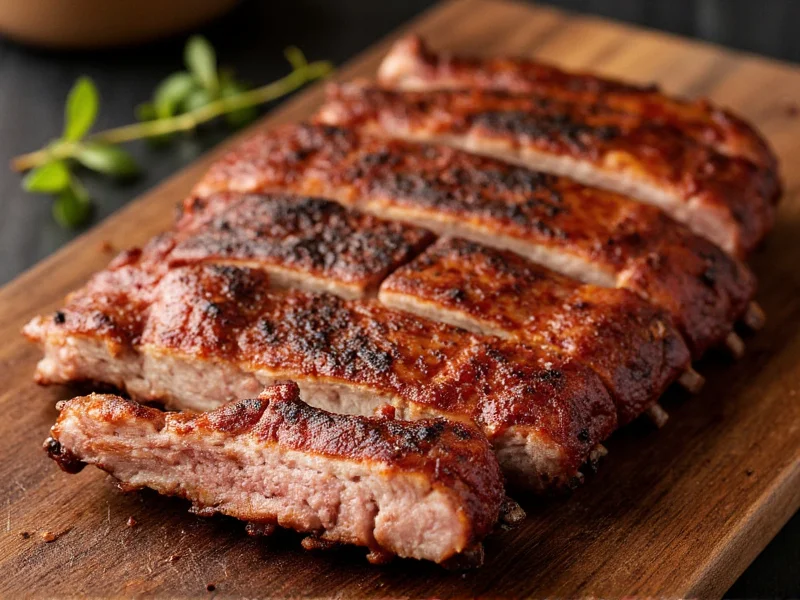Understanding the distinction between pork and beef ribs is essential for both home cooks and restaurant patrons. While both come from the rib section of their respective animals, they differ significantly in size, flavor, cooking methods, and culinary prevalence.
The Prevalence of Pork Ribs in Modern Cuisine
When you order \"ribs\" at a barbecue restaurant, see ribs on a menu, or find them at your local grocery store, you're almost certainly getting pork ribs. This culinary convention has developed for several practical reasons:
- Pork ribs are more affordable and widely available than beef ribs
- They have a higher meat-to-bone ratio that appeals to most consumers
- Pork ribs cook faster and require less specialized preparation
- They've become culturally associated with American barbecue traditions
The three primary types of pork ribs you'll encounter include:
| Type of Pork Ribs | Characteristics | Common Preparation |
|---|---|---|
| Baby Back Ribs | Smaller, curved, leaner, more tender | Grilled, smoked, often with sweet glazes |
| Spare Ribs | Larger, flatter, more fat and connective tissue | Slow-smoked, often trimmed to St. Louis style |
| St. Louis Style | Spare ribs trimmed into rectangular shape | Barbecued with dry rubs or wet sauces |
Understanding Beef Ribs: A Different Culinary Experience
Beef ribs are distinctly different from pork ribs and are always specifically labeled as such. The confusion sometimes arises because of the term \"short ribs,\" which refers to beef ribs cut from the plate section rather than the back ribs.
There are two main types of beef ribs:
- Beef Back Ribs - Cut from the upper rib section near the spine, these have less meat but are more tender
- Beef Short Ribs - Cut from the plate section, these are meatier with more marbling and connective tissue
Beef ribs require different cooking approaches than pork ribs. They're typically larger, meatier, and need longer cooking times due to their higher collagen content. Short ribs especially benefit from slow-cooking methods like braising or smoking for extended periods.
Why Pork Ribs Dominate the \"Ribs\" Market
Several factors contribute to pork ribs being the default when the term \"ribs\" is used without specification:
The difference between pork ribs and beef ribs extends beyond just the animal source. When considering what kind of ribs are most common in American dining culture, pork ribs have become synonymous with the term through decades of culinary tradition. This is particularly evident when examining restaurant menus where \"ribs\" without qualification almost exclusively means pork ribs.
Regional variations do exist—some areas with strong Texan barbecue traditions might feature beef ribs more prominently—but nationally, pork remains the standard interpretation of the unqualified term.
How to Identify Which Ribs You're Getting
To avoid confusion when purchasing or ordering ribs, look for these distinguishing characteristics:
- Pork ribs are smaller, with bones typically 3-6 inches long and more curved shape
- Beef ribs are larger, with straighter, thicker bones often 6-12 inches long
- Menu terminology: \"Baby backs\" or \"spare ribs\" = pork; \"beef ribs\" or \"short ribs\" = beef
- Price point: Beef ribs generally cost more per pound than pork ribs
Understanding why pork ribs are more popular than beef ribs helps explain this culinary convention. Pork ribs offer a more approachable eating experience for most consumers with their smaller size, milder flavor, and faster cooking time compared to the more substantial beef ribs.
Cooking Considerations for Each Type
The cooking methods for pork ribs vs beef ribs differ significantly due to their structural differences:
Pork ribs typically cook in 4-6 hours at 225-250°F when smoked, or 1.5-2 hours when grilled. They respond well to sweet and tangy barbecue sauces and dry rubs with paprika, garlic, and brown sugar.
Beef ribs, particularly short ribs, often require 10-14 hours of smoking or 3-4 hours of braising to properly break down their tougher connective tissues. They pair better with robust seasonings like coffee, chili powder, and black pepper that can stand up to their stronger flavor.
When exploring the difference between pork ribs and beef ribs cooking requirements, the time investment for beef ribs is substantially higher, which contributes to why pork ribs dominate casual dining and home cooking scenarios where time efficiency matters.











 浙公网安备
33010002000092号
浙公网安备
33010002000092号 浙B2-20120091-4
浙B2-20120091-4